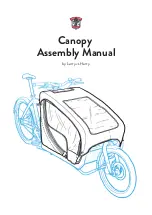
4
5
BICYCLE
SAFETY
BICYCLE
SAFETY
CAUTION:
Wheels must be true for hand brakes to
work effectively. Wheel truing is a skill which requires
special tools and experience. Do not attempt to true
a wheel unless you have the knowledge and tools
needed to do the job correctly.
3. BRAKES
If your bicycle has hand-operated brakes, squeeze the
brake levers. Are the brake shoes contacting the wheel rim
within an inch of brake lever movement? Can you apply
full braking force at the levers without having them touch
the handlebar? If not, your brakes need adjustment. Do
not ride the bike until the brakes are properly adjusted. If
your bicycle has a coaster brake, check to make sure that
the coaster brake arm is securely clamped to the bicycle
frame. If the arm or its mounting bracket are loose, do not
ride the bike until the brake arm is properly secured. See
page 32.
WARNING:
Riding with improperly adjusted and se-
cured brakes or worn brake shoes is dangerous and can
result in serious injury or death.
4. WHEEL NUTS
Are the front and rear wheels straight and secure in the
dropouts? Are the wheel nuts properly tightened?
WARNING:
Riding with an improperly installed or
insuficiently tightened wheel can cause the wheel to
wobble or disengage from the bicycle, which can cause
damage to the bicycle and serious injury or death.
5. HANDLEBAR AND SADDLE ALIGNMENT
Are the saddle and handlebar stem correctly parallel
to the bike’s top tube and tight enough so that you
can’t twist them out of alignment?
6. HANDLEBAR ENDS
Are the handlebar grips secure and in good condition?
If not, replace them. Are the handlebar ends plugged?
If not, plug them before you ride.
WARNING:
Loose or damaged handlebar grips can
cause you to lose control and fall. Unplugged handle-
bars can act like a cookie cutter on your body, and
cause serious injury in an otherwise minor accident.
RIDING SAFELY
AND RESPONSIBLY
NOTE:
Like any sport, bicycling involves risk of injury
and damage. By choosing to ride a bicycle, you assume
the responsibility for that risk. Not the people who sold
you the bike. Not the people who made it. Not the
people who distribute it. Not the people who manage or
maintain the roads or trails you ride on. You. So you
need to know - and to practice - the rules of safe and
responsible riding.
AN IMPORTANT NOTE TO PARENTS
In addition to The Basics (page 7), the Rules of the
Road (page 7), the Rules of the Trail (page 9), Wet
Weather Riding (page 9), Night Riding (page 10)
and Bicycling in Trafic (page 12) kids need to be
taught...and to have frequently reinforced...the following
rules and lessons which adults are already
expected to know. We urge you to take the time to
familiarize yourself with these rules and to teach them
to your child before you let your child ride
unsupervised.
1. RULES
• No playing in the road or in the street
• No riding on busy streets.
• No riding at night.
• Stop for all STOP signs.
• Ride on the right of trafic.
2. LESSONS
The lessons that follow relate to some of the most
common real situations that children encounter when
riding their bikes. Go over these situations with your
child and make sure the lesson objective is
accomplished.
Driveway Rideout:
When a youngster rides out
of the driveway and is struck by a car, that is called a
rideout accident.
What can you do?
First, realize the danger of your own driveway. If
there are obstructions to the view of passing
motorists (like bushes or trees), trim them back.
You might park your car in front of the driveway, if
local ordinance permits. This way, your child can’t
use the driveway as a launching pad.
But the most important thing you can do is teach
your child about driveway safety. Take your child
outside to the driveway and have him/her practice
the following steps:
• Stop before entering the street.
• Look left, right and left again for trafic.
• If there’s no trafic, proceed into the roadway. Running
the Stop Sign: Car/bike crashes can happen when a
cyclist runs a stop sign. Most cyclists who get hit riding
through stop signs know that they were supposed to
stop. They just thought it would be OK this time; or they
may have been distracted. The thing to impress upon
your child is that while he/she may not get hit every time,
running stop signs will eventually result in an accident.





































